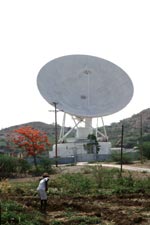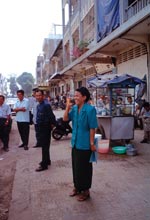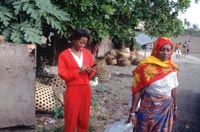Building bridges to the digital age
|

Photo: EyeWire (ITU 020058)
|
The International Telecommunication
Union is not just talking about bridging the digital divide, but is
actually doing something about it. This section discusses, under several themes,
some of ITU activities and projects that are building bridges for all to cross
the digital divide:
-
Countries in special need
-
Assistance to least developed countries
-
E-Strategy
-
E-health
-
Facilitating wireless access
-
Enabling connectivity
-
Minding the gender gap
Countries in Special Need
A recent workshop to launch the project
for countries in special need was upbeat in mood and outcomes. Held in
the “city in the sun”, as Kenya’s capital city, Nairobi, is often called,
the workshop (28 January to 2 February 2002) was co-hosted by ITU, the United
States Agency for International Development (USAID)/Leland Initiative and the
United States Federal Communications Commission (FCC). Participants left with
viable ideas and a large appetite to make a difference in their countries. They
were a diverse group with one common denominator: low teledensities and a
war-ridden past. The most underprivileged was the Democratic Republic of Congo
with the lowest fixed line teledensity of 0.04 and Internet penetration of 0.10.
Next was Somalia, whose teledensity stands at 0.15 and Internet penetration at
0.21. These two countries are bettered by Rwanda with a teledensity of 0.23 and
Internet penetration of 6.47 and Burundi whose teledensity stands at 0.30 and
Internet penetration of 4.48. Leading the group was Sierra Leone, with a
teledensity of 0.47 and an Internet penetration of 14.37. The feeble fixed main
line teledensity is somew hat propped up by robust growth of the cellular
networks, which are in dire need of regulation, particularly in the Democratic
Republic of Congo and Somalia.
The project for countries in special need is being
implemented following the adoption of Resolution 34 by the 1998 Minneapolis
Plenipotentiary Conference, which calls for assistance and support to be given
to countries whose telecommunication facilities and infrastructure have been
severely damaged and destroyed by war and civil strife. Although no budgetary
allocation was made at the time, two key partners have lent their support to the
project. USAID/Leland Initiative and FCC have teamed with ITU in supporting the
development of a modern regulatory framework through the design and development
of fundamental technical plans and basic technical norms for an efficient
national telecommunication system. ITU has made a financial injection of CHF 1
242 000 into the project using funds from its TELECOM Surplus Fund.
In addition, a total of USD 2 million was approved on 11
March 2002 by ITU’s TELECOM Surplus Programme Steering Committee to finance
projects in two equal parts in Burundi and Rwanda.
The ITU TELECOM Surplus Programme provides a vital source of
seed funding for projects that are helping bring the benefits of information and
communication technologies to those most in need. In the early days of the
Programme, ITU assisted Bosnia and Herzegovina through a specially developed
Plan of Action. Within the scope of this Plan, and in partnership with the
European Bank for Reconstruction and Development (EBRD), the country’s
Telecommunication Law was drafted and its Telecommunication Regulatory Agency
(TRA) established. During 2000, ITU provided USD 460 000 of assistance to TRA
through the Programme. One important result of this assistance was the purchase
of a Mobile Frequency Monitoring Unit to bolster effective spectrum management
in that country.
Assistance to least developed countries
The Special Programme for the least
developed countries (LDC) will be valued for its service aimed at
integrating LDCs into the world economy through telecommunication development.
LDCs are defined as low-income countries that are suffering from long-term
handicaps to growth, in particular low levels of human resource development
and/or severe structural weaknesses. They are listed as such by the United
Nations General Assembly which reviews the list every three years. The next
review is in the year 2003.
There are 49 LDCs in the world today. And ITU is helping them
to meet the demand for telecommunication services. This means virtually
eliminating the waiting list for services in urban areas by the year 2005 —
which translates into an average urban main line (ML) density of 10 per 100
inhabitants — and achieving a rural ML density of 2 per 10 000 inhabitants.
The second World Telecommunication Development Conference
held in Valletta (Malta) in 1998 decided that ITU assistance should be
concentrated on a small number of countries at a time in order to achieve
greater impact with the limited funds available. This focused and concentrated
assistance was provided to four countries in 1999, six countries in both 2000
and 2001
|

(ITU 910095)
|
Eight countries have been selected to benefit from
concentrated assistance in 2002: Haiti, Djibouti, Bhutan, Kiribati, Central
African Republic, Mali, Malawi and Zambia.
In 2001, Nepal received assistance to migrate from its public
switched telephone network (PSTN) to an Internet protocol-based project.
Guinea-Bissau benefited from a comprehensive study on sector restructuring.
Mozambique received assistance in the development of its universal access
policy. Niger got assistance in rural telecommunication development, allowing it
to modernize seven of its provincial towns. Eritrea received assistance to
develop a business plan aimed at the establishment of a telecommunication
development college. Yemen was a beneficiary of a teletraffic engineering
consultancy.
In 2000, ITU directed its concentrated assistance to
Cambodia, Chad, Comoros, Ethiopia, Sudan and the United Republic of Tanzania. In
the area of sector restructuring, Cambodia, Comoros and Ethiopia expressed
profound appreciation for ITU assistance. Haiti was dropped from the list due to
political instability in the country. Sudan benefited from consultancies on
planning and tariffs, while Tanzania had a mixed bag of consultancies for policy
on universal access/service, spectrum management and interconnection mechanisms.
|

(ITU 990086)
|
Results to date
Looking at the teledensities of 1999
and 2000, there has already been some progress made by the countries that
benefited from ITU assistance. The average teledensity has increased by 0.16
rising from an average of 0.42 teledensity in 1998 (i.e. before the
implementation of the Valletta Action Plan adopted in March 1998) to 0.58 in
2000. Sudan and Uganda performed best in the group with teledensity increasing
from 0.57 and 0.3 in 1998 to 1.24 and 1.3, respectively, in 2000. Assistance to
Sudan in 2000 in the area of human resources development/management accounts for
the country’s improved performance.
According to statistics for 2001, 26 of the 49 LDCs have a
combined (fixed and mobile) teledensity above 1 compared to the average ML of
0.3 in 1994. Judging from the current rate of growth in the telecommunication
sector, and level of assistance flowing from ITU to LDCs, however, it is
unlikely to achieve the targets set in the Valletta Action Plan within the
stated time frame of 2005. Nevertheless, if the level of assistance is stepped
up, it is possible to increase the average telephone density to 5 main lines per
100 inhabitants and Internet connections to 10 users per 100 inhabitants by the
year 2010 — a new goal enshrined in the Programme of Action for LDCs for the
decade 2001–2010. This new goal was set at the Third United Nations Conference
on the Least Developed Countries held in Brussels in May 2001.
|

(ITU 950040)
|
Taking all LDCs as a group, some 10 of them are doing
extremely well and have already exceeded the 2005 target, while another 10 to 20
will meet the target, but the whole group will be pulled down by the counter
performance of those dozen States that were afflicted by civil strife.
The main constraint in the implementation of the LDC
programme is the insufficient financing. There is need for a high initial cash
outlay to be directed at assisting selected countries jump-start their
telecommunication sector throughout the year. Standby funds should be available
to continue ad-hoc work in “weaned” countries so as to maintain momentum on
initiated projects. Future funding of projects will most likely come from the
private sector. The two partnership round-tables held in Geneva in November
2000, and in Johannesburg (South Africa) in November 2001 for the beneficiaries
of the concentrated assistance during both years were telling. It became
apparent, from both events, that the interest of development banks in financing
such projects had waned.
For more information, contact: Cosmas L. Zavazava, Special
Unit for LDCs and International Organizations. Tel.: +41 22 730 5447 Email: zavazava@itu.int
U 950040) (ITU 990086) (ITU 910095)
|